2020 Thesis Cohort
On this page:
Maybeleen Apwong
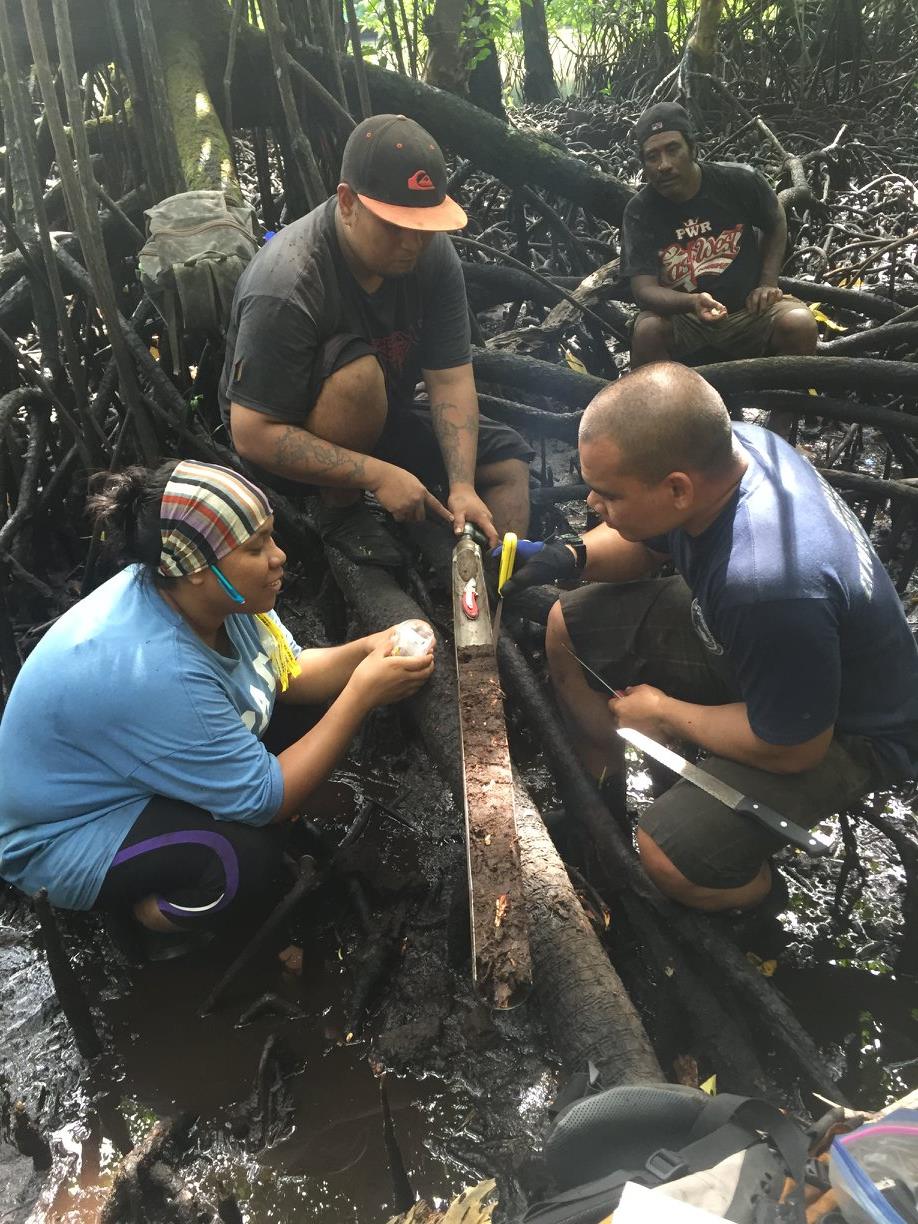 Maybeleen is from Pohnpei. Her thesis is on the abiotic and biotic drivers of sedimentation and carbon burial in Mangroves of Pohnpei and Kosrae, Federated States of Micronesia. When asked for a fun fact, she said mangrove trees grow where no trees should be able to grow. She has worked with a lot of mangrove experts since she began her thesis and has realized how small this niche is in real life. The work and travel are intense, but fun all the same. Expanding knowledge and creating networks in the field has been illuminating for her. Her favorite part of the thesis experience is that she gets to work with so many different people in the field. Writing is the most important but also most challenging part for her, especially when putting all the research together.
Maybeleen is from Pohnpei. Her thesis is on the abiotic and biotic drivers of sedimentation and carbon burial in Mangroves of Pohnpei and Kosrae, Federated States of Micronesia. When asked for a fun fact, she said mangrove trees grow where no trees should be able to grow. She has worked with a lot of mangrove experts since she began her thesis and has realized how small this niche is in real life. The work and travel are intense, but fun all the same. Expanding knowledge and creating networks in the field has been illuminating for her. Her favorite part of the thesis experience is that she gets to work with so many different people in the field. Writing is the most important but also most challenging part for her, especially when putting all the research together.
Trevor Chambers
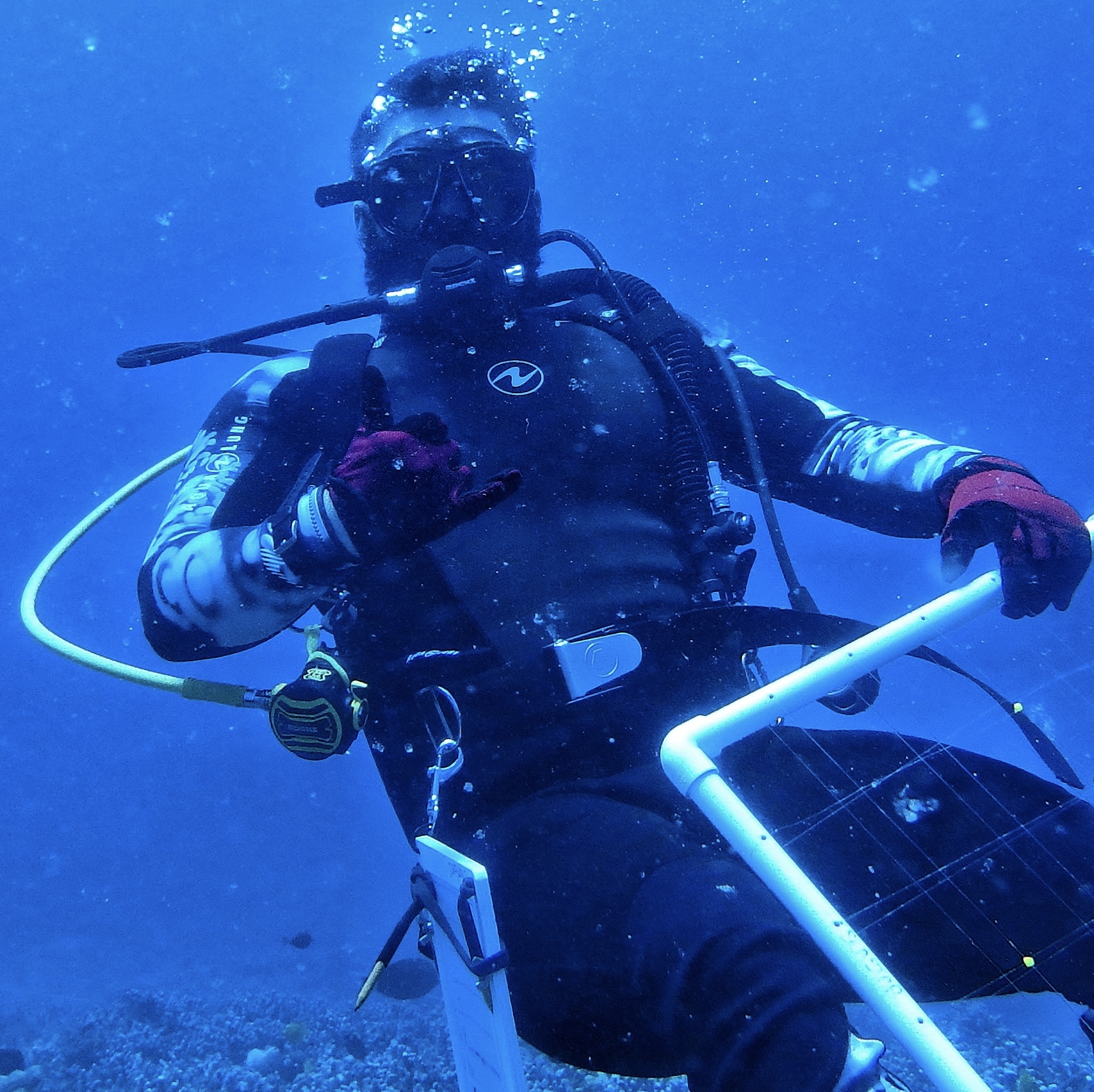 Trevor is from Northeast Ohio. For his thesis, he is developing A Carbon Life Cycle Analysis, examining the CO2 emissions related to the deployment and lifetime of The Blue Fields Project while comparing the emissions of different nutrient sources (Sea Surface Water, Deep Sea Water, and Artificial Fertilization). He is working with Ocean Era Inc. who's lab is located at the Natural Energy Laboratory of Hawai'i (NELHA) in The Hawai'i Ocean Science & Technology Park (HOST Park) Ahupua'a Kalaoa. He is working with Ocean Era Inc. on The Blue Fields Offshore Macroalgae (limu) Demonstration Project (The Blude Fields Project) as part of ARPA-E’s (Advanced Research Projects Agency – Energy) MARINER (Macroalgae Research Inspiring Novel Energy Resources) program. ARPA-E’s MARINER program seeks to develop tools to enable the United States to become a global leader in the production of marine biomass through the development of novel technologies capable of providing economically viable, and renewable biomass without the need for land, fresh water, or synthetic fertilizers. Ocean Era is deploying a submersible platform for growing native Hawaiian limu approximately 1.5 nautical miles offshore and adjacent to Pawai Bay and the Old Airport County Recreation Park, in Kailua-Kona, Hawaiʻi. Ocean Era is examining artificial Deep Sea Water upwelling as a nutrient enhancement method to increase biomass production within The Blue Fields Project. He has enjoyed the opportunity working alongside Ocean Era, Makai Engineering, Argonne National Labs, and Dr. Kevin Hopkins. He also enjoyed attending and presenting his research at The World Aquaculture Society's, Aquaculture 2022 conference, in San Diego. He is inspired by the future of ocean farming and the impact it will have on the availability of food and fuel. His favorite part of his thesis experience was taking the scientific diver course. He was able to meet students in his cohort in person for the first time and established great friendships through the opportunity. The most challenging part of his time in TCBES was pursuing grad school during a global pandemic, which meant lots of time on a computer, and more difficulty building relationships with instructors and classmates.
Trevor is from Northeast Ohio. For his thesis, he is developing A Carbon Life Cycle Analysis, examining the CO2 emissions related to the deployment and lifetime of The Blue Fields Project while comparing the emissions of different nutrient sources (Sea Surface Water, Deep Sea Water, and Artificial Fertilization). He is working with Ocean Era Inc. who's lab is located at the Natural Energy Laboratory of Hawai'i (NELHA) in The Hawai'i Ocean Science & Technology Park (HOST Park) Ahupua'a Kalaoa. He is working with Ocean Era Inc. on The Blue Fields Offshore Macroalgae (limu) Demonstration Project (The Blude Fields Project) as part of ARPA-E’s (Advanced Research Projects Agency – Energy) MARINER (Macroalgae Research Inspiring Novel Energy Resources) program. ARPA-E’s MARINER program seeks to develop tools to enable the United States to become a global leader in the production of marine biomass through the development of novel technologies capable of providing economically viable, and renewable biomass without the need for land, fresh water, or synthetic fertilizers. Ocean Era is deploying a submersible platform for growing native Hawaiian limu approximately 1.5 nautical miles offshore and adjacent to Pawai Bay and the Old Airport County Recreation Park, in Kailua-Kona, Hawaiʻi. Ocean Era is examining artificial Deep Sea Water upwelling as a nutrient enhancement method to increase biomass production within The Blue Fields Project. He has enjoyed the opportunity working alongside Ocean Era, Makai Engineering, Argonne National Labs, and Dr. Kevin Hopkins. He also enjoyed attending and presenting his research at The World Aquaculture Society's, Aquaculture 2022 conference, in San Diego. He is inspired by the future of ocean farming and the impact it will have on the availability of food and fuel. His favorite part of his thesis experience was taking the scientific diver course. He was able to meet students in his cohort in person for the first time and established great friendships through the opportunity. The most challenging part of his time in TCBES was pursuing grad school during a global pandemic, which meant lots of time on a computer, and more difficulty building relationships with instructors and classmates.
Rose Criscione
Rose is originally from Illinois. Her thesis is entitled, “Colormetric determination of Glyphosate using ozonolysis followed by spectrophotometric analysis of the phosphate group with Molybdenum Blue Reagent (MBR)”. She is conducting her research with the UH Hilo Chemistry Department/Platz Lab. The technique she is developing will allow for non-professionals, high-school students, field-workers to survey for the most commonly applied herbicide in streams, rivers, and nearshore coastal environments. She had the awesome opportunity to help keiki develop their own experiments pertaining to the cultivation of Hawaiian limu. It was such a blast preparing their little cultivation baggies! The class decided to test various salinity concentrations on the growth rate of Caulerpa lentillifera (commonly called sea-grapes). Her favorite part of her thesis experience has been the collaboration. The most challenging part is knowing when to stop reading articles.
Erika Kekiwi
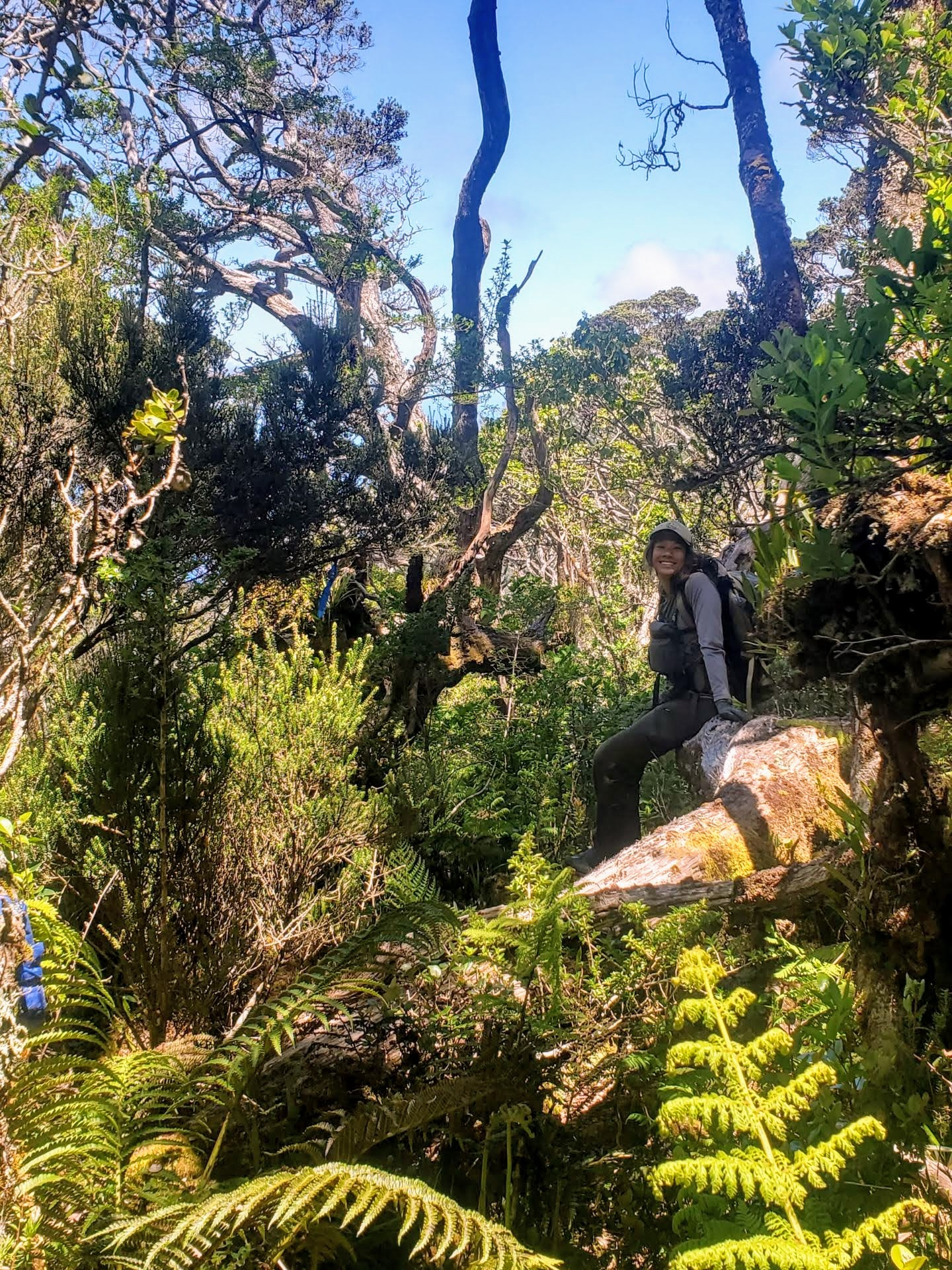 Erika grew up on Maui, Hawai‘i. Her thesis is on using bioacoustics to study critically-endangered Maui forest birds. She conducts her research in the Mokupuni of Maui, Moku of Ko'olau, Kīpahulu, Kaupō. A fun fact she gave is that the ʻākohekohe is the largest honeycreeper on Maui and can often be seen chasing other birds from the ʻōhiʻa. During her time as a graduate student, she was able to continue to do field work on Maui for her research, a lot of which involved servicing songmeters in rainforest areas. On one such trip, she and her boss detected the first kiwikiu recorded in that area in about ten years! Her favorite part of her work has been building pilina in the wahi pana where the kiwikiu and ʻākohekohe reside! The most challenging part is being glued to a computer and spending the tedious time making thousands of selections of vocalizations from my target species.
Erika grew up on Maui, Hawai‘i. Her thesis is on using bioacoustics to study critically-endangered Maui forest birds. She conducts her research in the Mokupuni of Maui, Moku of Ko'olau, Kīpahulu, Kaupō. A fun fact she gave is that the ʻākohekohe is the largest honeycreeper on Maui and can often be seen chasing other birds from the ʻōhiʻa. During her time as a graduate student, she was able to continue to do field work on Maui for her research, a lot of which involved servicing songmeters in rainforest areas. On one such trip, she and her boss detected the first kiwikiu recorded in that area in about ten years! Her favorite part of her work has been building pilina in the wahi pana where the kiwikiu and ʻākohekohe reside! The most challenging part is being glued to a computer and spending the tedious time making thousands of selections of vocalizations from my target species.
Stephanie Mladinich
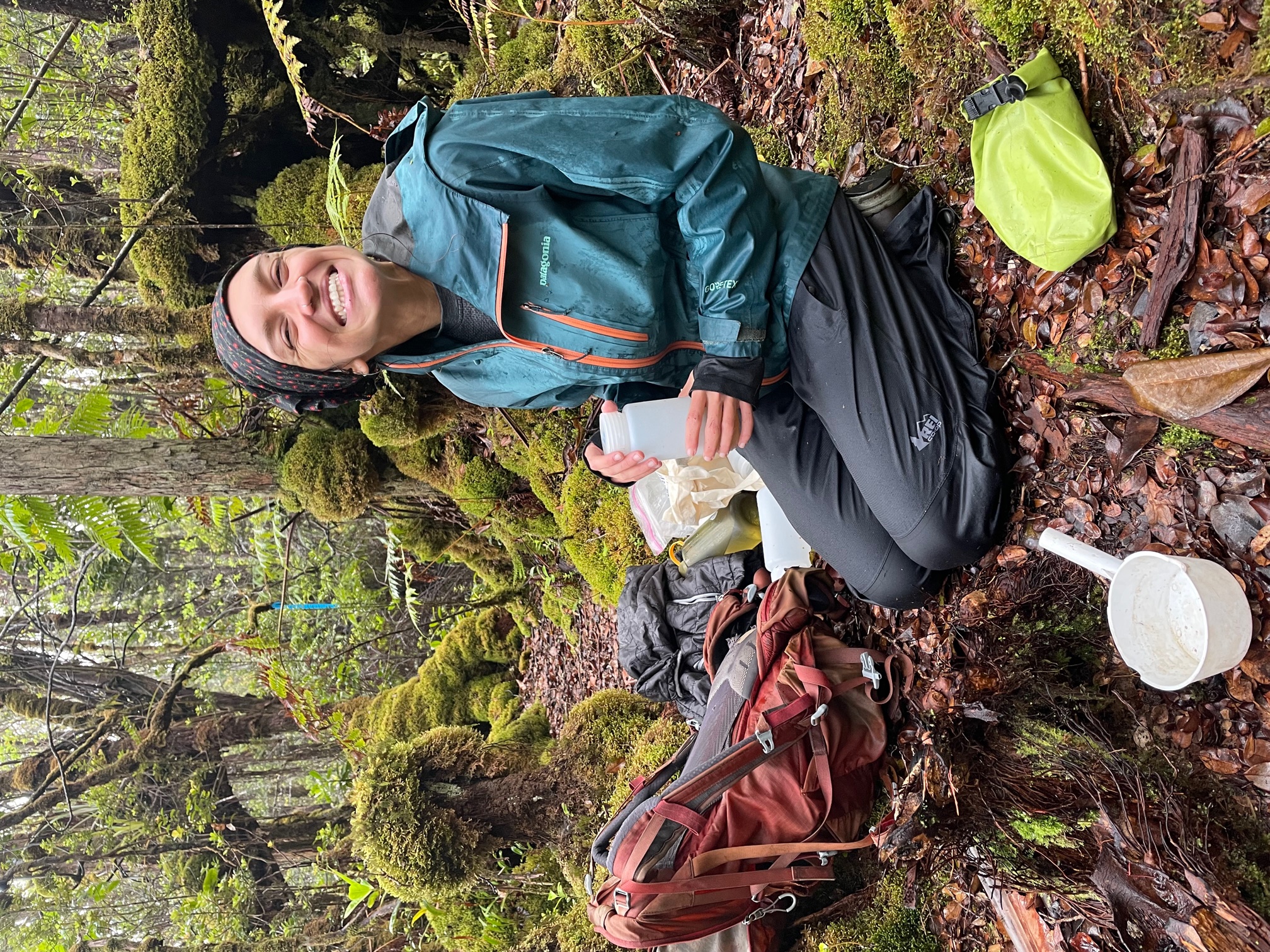 Stephanie is from Albuquerque, New Mexico. For her thesis, she is working on the development of an early warning system for climate-change related invasion by mosquitoes into Hakalau Forest NWR. She is conducting her research in Hakalau Forest National Wildlife Refuge in the ahupuaʻa of Hakalau, moku of Hilo and Laupāhoehoe Forest Reserve in the ahupuaʻa of Laupāhoehoe in the moku of North Hilo. A fun fact related to her research is that there are more than 3,500 species of mosquito in the world. Through her research, she’s had the opportunity to collaborate with agencies across the islands to share knowledge and support improved and standardized mosquito monitoring, as well as participate in partner projects conducting mosquito surveys and collecting data on avian malaria infections in native forest birds. Her favorite part of her research is spending time in the forest at Hakalau FNWR. The most challenging part is tackling diverse research questions in a limited amount of time.
Stephanie is from Albuquerque, New Mexico. For her thesis, she is working on the development of an early warning system for climate-change related invasion by mosquitoes into Hakalau Forest NWR. She is conducting her research in Hakalau Forest National Wildlife Refuge in the ahupuaʻa of Hakalau, moku of Hilo and Laupāhoehoe Forest Reserve in the ahupuaʻa of Laupāhoehoe in the moku of North Hilo. A fun fact related to her research is that there are more than 3,500 species of mosquito in the world. Through her research, she’s had the opportunity to collaborate with agencies across the islands to share knowledge and support improved and standardized mosquito monitoring, as well as participate in partner projects conducting mosquito surveys and collecting data on avian malaria infections in native forest birds. Her favorite part of her research is spending time in the forest at Hakalau FNWR. The most challenging part is tackling diverse research questions in a limited amount of time.
Crispin Nakoa
Crispin is from Hilo, Hawai‘i. He conducted his master’s thesis on identifying sewage pollution hotspots in the nearshore waters of Hilo. His research has taken place throughout the moku of Hilo, mainly within the portion of the Waiākea ahupuaʻa from Lehia to the mouth of the Wailuku River, but also including the ahupuaʻa of Honoliʻi. This research is especially meaningful to him because he has had a memorable experience from my earlier life at all 20 of my sampling stations throughout Hilo. He has been able to have conversations about his research and findings with many people that he knew through growing up in Hilo while collecting water samples along the coastline for his thesis project. He feels lucky to share the information he has gained through his graduate studies through many presentations to community members, fellow graduate students, and undergraduate students. His favorite part of this experience has been working on his thesis research to answer many questions that he has had nearly his entire life. He also enjoys that he gets to share his findings with the many other stakeholders in the community, many of whom have either grown up with him or watched him grow up surfing and fishing in Hilo and have had similar questions about the water quality here. The most challenging thing that he did for his thesis was working to complete all classwork and field work by his third semester in order to have a full semester dedicated to the final analyses of samples, data, and completing my dissertation.
Naya O'Reilly
 Naya O'Reilly's hometown of San Diego, California, nurtured its relationship with the marine conservation efforts. They first sought academic rigor while obtaining their Bachelor's degree from the University of Colorado, Boulder in Environmental Studies with a minor in Atmospheric and Oceanic Sciences. Their Honors thesis was a socioeconomic analysis of fecal indicator bacteria, which cemented their love for research. At UH Hilo, they worked with Dr. Adam Pack and the Marine Mammal Lab on fluke identification projects, the Hawaiian Islands Large Whale Entanglement Network, and NOAA Fisheries Management. Their master's thesisThe Cost of Conservation of Hawaiian Island Humpback Whales: An Assessment of Bycatch Mitigation Interventions for Humpback Whales in Hawai'i, is a cost and benefit analysis of 15 mitigation efforts for Hawaiian and Alaskan Fisheries. They have recently returned from field research on food preferences in Madagascar with the Global Sustainability Scholars.
Naya O'Reilly's hometown of San Diego, California, nurtured its relationship with the marine conservation efforts. They first sought academic rigor while obtaining their Bachelor's degree from the University of Colorado, Boulder in Environmental Studies with a minor in Atmospheric and Oceanic Sciences. Their Honors thesis was a socioeconomic analysis of fecal indicator bacteria, which cemented their love for research. At UH Hilo, they worked with Dr. Adam Pack and the Marine Mammal Lab on fluke identification projects, the Hawaiian Islands Large Whale Entanglement Network, and NOAA Fisheries Management. Their master's thesisThe Cost of Conservation of Hawaiian Island Humpback Whales: An Assessment of Bycatch Mitigation Interventions for Humpback Whales in Hawai'i, is a cost and benefit analysis of 15 mitigation efforts for Hawaiian and Alaskan Fisheries. They have recently returned from field research on food preferences in Madagascar with the Global Sustainability Scholars.
Amberly Pigao
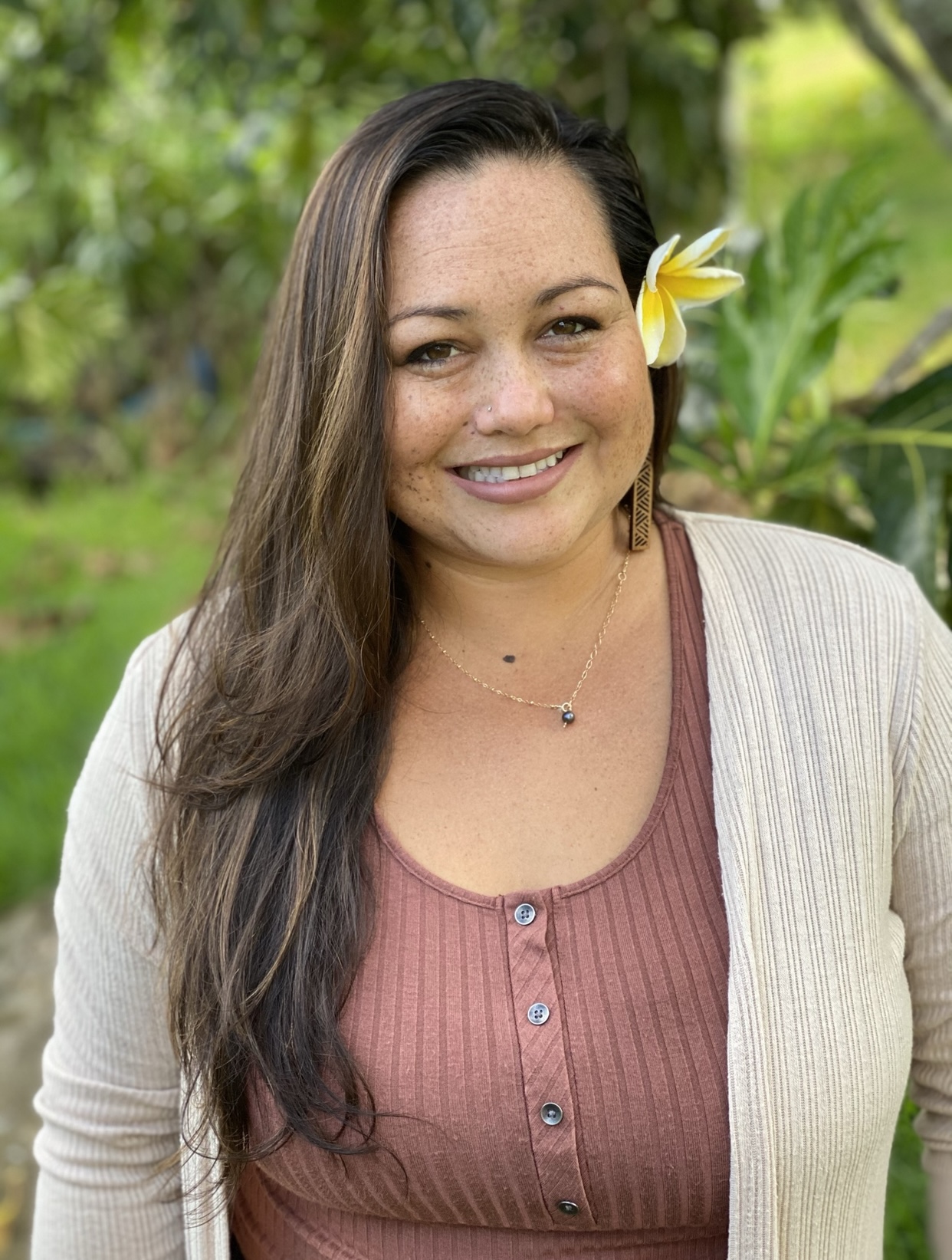 Amberly is from Kapaʻa, Kauaʻi. Her thesis is on optimizing forest restoration techniques to increase endangered species habitat and mitigate future drought: Kanakaleonui Bird Corridor. Her research is conducted at Puʻu Kanakaleonui within Humuʻ ula ahupuaʻa. This area is very unique because itʻs a high elevation sub-alpine forest which also has characteristics of a Tropical Montane Cloud Forest with daily fog cover. This is one of the few fog capture studies to be conducted on Mauna Kea. Amberly has a PIPES intern this summer. They are conducting a soil study for her nurse tree experiment testing for nitrogen and carbon. They will compare the nutrient levels with the success rates of seedlings that are planted within the nurse treeʻs drip line. Her favorite part about her thesis experience is watching the native seedlings as they continue to grow; some even produced flowers and seeds. Some plants are now 6 feet tall. Itʻs inspiring to know that some of these plants will become trees creating a future forest. The most challenging issue that continues to arise throughout the entirety of her project is getting reliable 4-wheel drive vehicles. Her project is extremely remote with a 2-3 hour drive time. Reliable transportation is crucial for the safety of researchers and the success of the project.
Amberly is from Kapaʻa, Kauaʻi. Her thesis is on optimizing forest restoration techniques to increase endangered species habitat and mitigate future drought: Kanakaleonui Bird Corridor. Her research is conducted at Puʻu Kanakaleonui within Humuʻ ula ahupuaʻa. This area is very unique because itʻs a high elevation sub-alpine forest which also has characteristics of a Tropical Montane Cloud Forest with daily fog cover. This is one of the few fog capture studies to be conducted on Mauna Kea. Amberly has a PIPES intern this summer. They are conducting a soil study for her nurse tree experiment testing for nitrogen and carbon. They will compare the nutrient levels with the success rates of seedlings that are planted within the nurse treeʻs drip line. Her favorite part about her thesis experience is watching the native seedlings as they continue to grow; some even produced flowers and seeds. Some plants are now 6 feet tall. Itʻs inspiring to know that some of these plants will become trees creating a future forest. The most challenging issue that continues to arise throughout the entirety of her project is getting reliable 4-wheel drive vehicles. Her project is extremely remote with a 2-3 hour drive time. Reliable transportation is crucial for the safety of researchers and the success of the project.
Anuhea Robins
Anuhea is from Wai‘anae, O‘ahu. Her master’s thesis is on linking the functional traits of leaf litter and litter-dwelling arthropods to predict ecological interactions in Hilo, Hawai‘i. Among the invaluable lessons she’s learned, one is that “underestimating the a‘a substrate will lead to patella dislocations and nasty gashes on your shins”. A big part of her research project and graduate school experience is mentorship, whether it be training interns and new hires on the Liko Nā Pilina project or mentoring UH Hilo undergraduate students in the Keaholoa STEM Scholars Program. Another important aspect of her graduate studies is community building, and organizing/participating in volunteer opportunities (through the TCBES Kaiameaola Club) with local non-profit organizations to strengthen her connections with and within Hilo. Her favorite part of her thesis experience has been meeting other students interested in restoration ecology. The most challenging thing she’s done for her thesis is substitute time in the field for more lab work.
Alexander Spengler
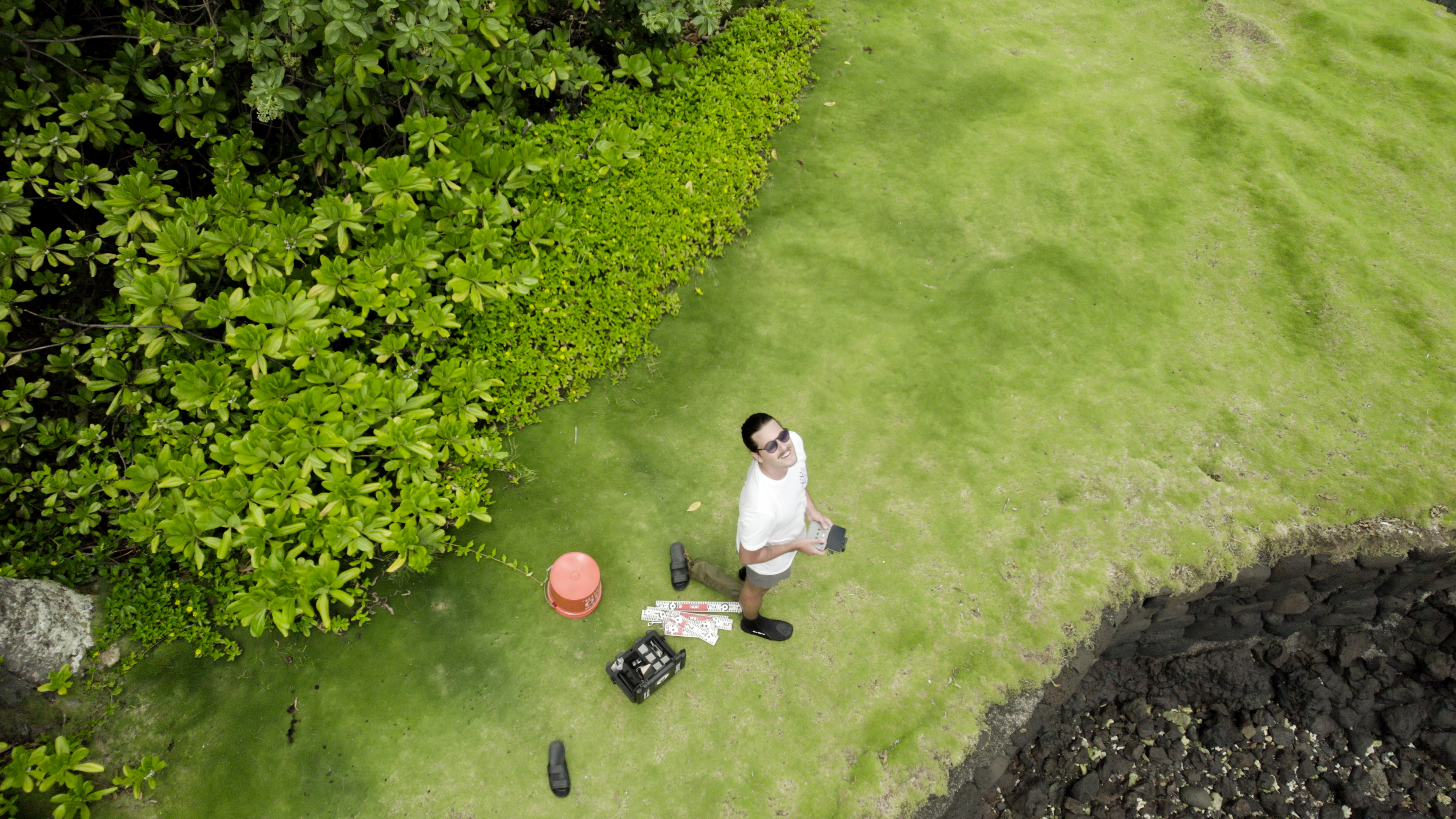 Alex is from Minnesota. His master’s thesis is entitled “Mapping a Reef in Minutes - Underwater Action Camera Photogrammetry”. He is conducting his research in Laehala located in the ʻili of Honohononui of Waiakea ahupuaʻa, South Hilo District, Island of Hawai‘i. Through his work, he has found that at low tide, many of the large mounding Porites corals protrude out of the water. Over time, the frequent exposure creates coral colonies that are donut shaped! He fills a number of roles in the MEGA Lab at UH Hilo. He routinely advises interns and undergraduates with their projects, provides educational outreach to local schools & communities, solo develops mobile applications, generates full 3D animations, and provides a wide variety of graphic design. He loves problem solving and like with many projects, there's often a lot of unexpected issues that arise. He enjoys the opportunity to be creative and entertain out of the box ideas in a scientific environment. He has learned a lot about personal accountability and about keeping himself accountable to deadlines and goals.
Alex is from Minnesota. His master’s thesis is entitled “Mapping a Reef in Minutes - Underwater Action Camera Photogrammetry”. He is conducting his research in Laehala located in the ʻili of Honohononui of Waiakea ahupuaʻa, South Hilo District, Island of Hawai‘i. Through his work, he has found that at low tide, many of the large mounding Porites corals protrude out of the water. Over time, the frequent exposure creates coral colonies that are donut shaped! He fills a number of roles in the MEGA Lab at UH Hilo. He routinely advises interns and undergraduates with their projects, provides educational outreach to local schools & communities, solo develops mobile applications, generates full 3D animations, and provides a wide variety of graphic design. He loves problem solving and like with many projects, there's often a lot of unexpected issues that arise. He enjoys the opportunity to be creative and entertain out of the box ideas in a scientific environment. He has learned a lot about personal accountability and about keeping himself accountable to deadlines and goals.
Shayla Waiki
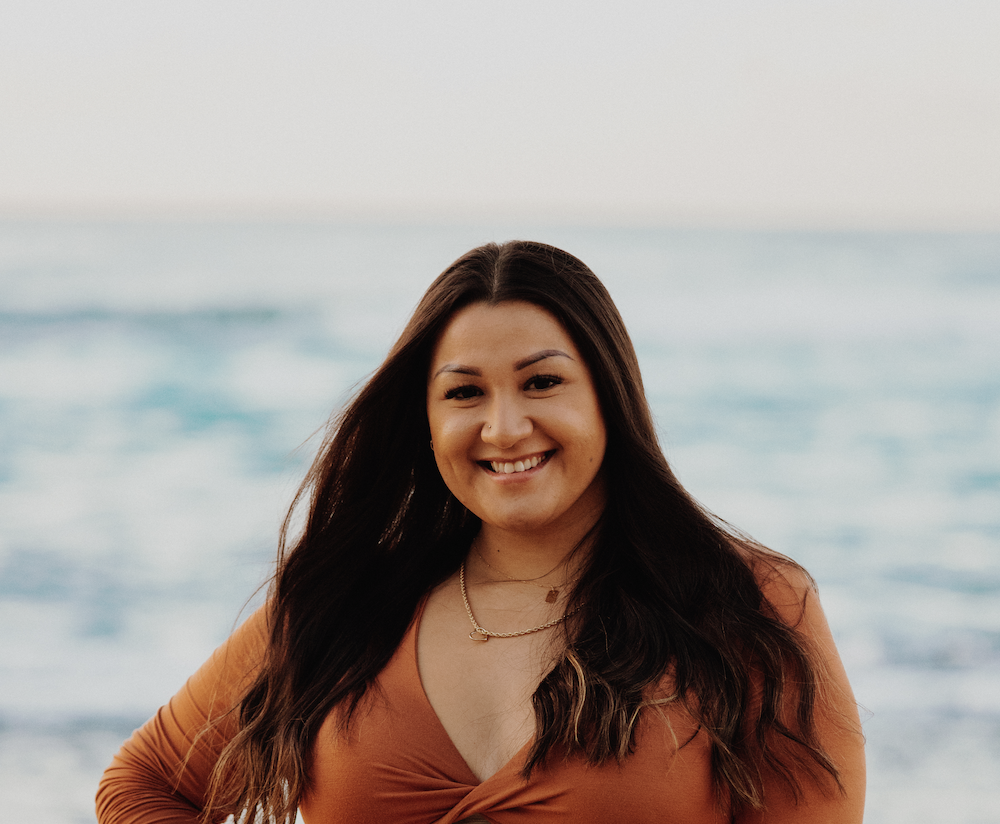 Shayla Waiki is from Hilo, Hawai'i. Her master's thesis focused on assessing sewage pollution in coastal waters of Keaukaha, Hawai'i. Her research included the use of dye tracer tests to determine the connectivity of cesspools to nearby shorelines and the use of fecal indicator bacteria (FIB) plus other measurements to characterize water quality in the region and from the Hilo Wastewater Treatment Plant. Her research helps to address the critical issue of sewage pollution in the Hawaiian Islands and reiterates the need for clean water for both the health of communities and the preservation of natural resources. Her master's research is especially important to her because it took place in the areas she grew up and helps to solve issues right here at home. Shayla had many favorites while pursuing her master's which included performing dye tracer tests, presenting and informing the community at Community Association meetings, but lab work was her favorite, it was the moment of truth that indicated just how impacted these areas were. Her master's journey was challenging, with finishing all coursework and fieldwork in three semesters, with the last for writing and analysis... but most of all it was rewarding!
Shayla Waiki is from Hilo, Hawai'i. Her master's thesis focused on assessing sewage pollution in coastal waters of Keaukaha, Hawai'i. Her research included the use of dye tracer tests to determine the connectivity of cesspools to nearby shorelines and the use of fecal indicator bacteria (FIB) plus other measurements to characterize water quality in the region and from the Hilo Wastewater Treatment Plant. Her research helps to address the critical issue of sewage pollution in the Hawaiian Islands and reiterates the need for clean water for both the health of communities and the preservation of natural resources. Her master's research is especially important to her because it took place in the areas she grew up and helps to solve issues right here at home. Shayla had many favorites while pursuing her master's which included performing dye tracer tests, presenting and informing the community at Community Association meetings, but lab work was her favorite, it was the moment of truth that indicated just how impacted these areas were. Her master's journey was challenging, with finishing all coursework and fieldwork in three semesters, with the last for writing and analysis... but most of all it was rewarding!
